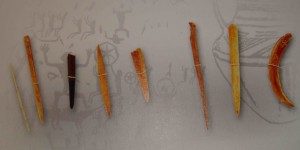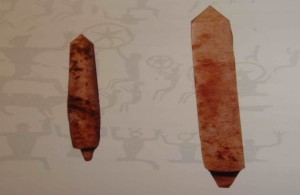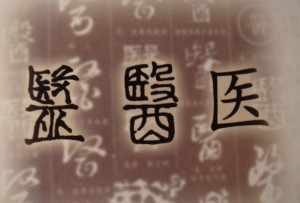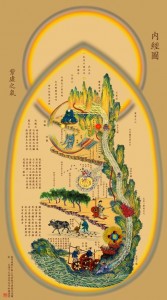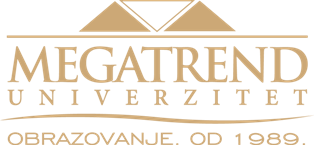Traditional Chinese medicine (in the further text – TCM) appeared 5000 years ago in the Neolithic China. During the Spring and Autumn periods (770 BC – 476 BC) and the Warring States period (475 BC – 221 BC) the theoretical foundation of TCM was created. The most important works related to TCM written during this period are:
- 山海经(Shanhai Jing) – “The Classics on the Mountains and Seas”
- 黄帝内经(Huangdi Neijing) – “The Canon of Medicine of the Yellow Emperor”
- 神农本草经(Shennong Bencao Jing) – “Shennong’s Classics on herbal medicine”
The basic principle of TCM is a holistic one. TCM is based on prevention of disease, the unity of man and nature (天人合一), the unity of body and spirit, and the balance between Yin and Yang.
MYTHOLOGY AND TCM
Mythology played an important role in the appearance of Chinese medical science, because at the very beginning of the development of human thought, man tried to explain secretive and mysterious phenomena by means of myth. Basic Chinese myths that are associated with the development of TCM are:
Pangu – the myth on creation: When the father of mankind Pangu came to life from the chaotic egg, he first created Yin and Yang – two basic elements of creation. Everything that exists, including human beings, is created by combining Yin and Yang.
Fuxi and Nuwa – Fuxi – the God of the Sun and Nüwa – the Goddess of the Moon are the incarnations of Yang and Yin, and they are humanity’s first parents, Chinese Adam and Eve. The universe is made of Yin and Yang. Yang originally refers to the Sun (Chinese word for the Sun is 太阳, Tai-yang, ie. The Almighty Yang) and represents a positive, active force, while Yin means a lack of the Sun (in Chinese 阴 – Yin means cloudy, in the shade, dark, hidden, the Moon) representing a negative force. The relationship between Yin and Yang is complementary and embodies opposition and unity at the same time. The theory of Yin and Yang which was developed from this concept formed the foundation of the understanding of the material world of the ancient Chinese, and became the theoretical basis for the appearance of TCM. The theory and clinical practice of TCM, including the understanding of psychology, pathology, disease prevention, treatment and recovery, fully developed from the theory of Yin and Yang.
Fuxi discovered 9 acupuncture needles – Fuxi is a legendary founder of acupuncture. According to tradition, Fuxi is the founder of 9 types of needles which are used in Chinese acupuncture:
- chanzhen – a needle in a shape of a blade
- yuanzhen – a round needle
- tizhen – an arrow tipped needle
- fengzhen – a sharppointed needle
- pizhen – the ‘sword’ needle
- yuanlizhen – a round sharp pointed needle
- haozhen – a fine needle
- changzhen – a long nedle
- dazhen – a big needle
Picture 1: Acupuncture needles from the Neolit
During the Stone and Bronze Age stone tools have played a major role in human society. The Bian stone is one of the earliest surgical instruments. It is a thin tool with a sharp point or blade, which was primarily used to open the boil, and drain pus and blood. It was probably used for therapeutic stimulation of specific points on the body at an early stage of acupuncture development. With further development, the Bian stones evolved into knives and needles. The Bian stones were also used for several thousand years after the end of the Stone Age. The primitive Bian evolved into stone blades and needles, which started to be made from bamboo, wood, bone, and later bronze, iron, silver and gold.
The Bian stone
Sui Renshi – Chinese Prometheus: he discovered fire by the friction of wood. According to archaeological excavations, in the south of China in Yunnan province the traces of carbonized materials were found near the fossil remains of the so-called Yuanmou homin 1.7 million years old. The invention of fire is crucial for the development of herbal medicine, for the thermal processing of herbal medicines, as well as the activation and increase the efficiency of certain plants. Of course, MOXIBUSTIA (the stimulation of acupuncture points by increasing their temperature with the help of moxa wool made of moxa plant, ie. absinth) is directly related to the discovery of fire.
- Shennong experimenting with 100 plants – traditional Chinese medications comprise various types of animal, vegetable and mineral substances. However, they are mostly made of herbal ingredients. According to a legend, Shennong, the Chinese god of medicine and agriculture, founded the TCM when he tried out on himself 100 plants for a day, 7 of which were poisonous. Namely, Shennong is the Yan tzar, one of the legendary ancestors of the Chinese people.
- Yi Yin discoveres plant essences – The essence is a type of traditional Chinese medication which is made by cooking different plants in water or extracting their healing ingredients. The legend has it that the essences were discovered by Yi Yin, the prime minister of King Tang of Shang Dynasty in the 16th century BC. Yi Yin was a cook and a doctor who discovered the first essences by cooking together different culinary flavors, such as cinnamon, ginger, licorice, jujube and peony. The discovery of herbal essences is of great historical significance. Plants were combined and cooked at the appropriate temperature. Combining of various medical substances led to the creation of the theory of compatibility of medicines. The emergence of herbal essences represents the beginning of Chinese pharmacology.
MAGIC AND TCM
People in their original societies believe in deities, magic and rituals. The rituals were performed by shamans who were believed to have magical power to communicate with deities. Shamans had multiple roles: divination, sacrifices, prayer for God’s protection, prediction of celestial phenomena, medical practice, etc.
Shamanism in China appeared during the late Paleolithic period (8000 BC), lasting through the Xia (2100 BC – 1600 BC), Shang (1600 BC – 1046 BC) and Western Zhou dynasty (1046 BC – 771 BC), when shamans had the role of communication with the gods and treatment of patients.
The development of the Chinese script shows the close relationship between shamanism and medicine. The hieroglyph for medicine 医 Yi used to include the radical (a part of the Chinese hieroglyph bearing the semantic meaning of the hieroglyph), denoting magic 巫 Wu. On the excavated cow shoulders blades and tortoise armors from the 1300 BC – 256 BC period, one can read that Chinese shamans treated the sick with the combination of traditional medications and magic rituals. Shamanic practices had two components: an effective medical treatment, as well as psychological support to the patient.
The appearance of hieroglyphs for medicine 医 Yi: original (left) hieroglyph consists of the upper radical Yi, which denotes “medicine” and a lower radical Wu, meaning “magic”. In today’s hieroglyph for medicine 医 Yi there is no Wu radical meaning “magic” any more.
HUANGDI NEIJING –“The Canon of Medicine of the Yellow Emperor”: the theoretical foundation of TCM
The Spring and Autumn Period (770 BC – 476 BC) and the Warring States period (475. BC – 221 BC) were characterized by political instability and frequent changes of power. On the spiritual level, this was a flourishing period, since the free exchange of thoughts and ideas prevailed – “a hundred schools of thought” were created (many philosophical schools). Many great thinkers traveled through China’s vast territory, presenting their ideas on power, culture, politics, literature, art and everyday life. This medical treatise appeared at that time. This treasure of TCM consists of 16 volumes and 162 chapters. It is a compilation of numerous medical books, records and studies of diseases.
The key concept of the “Canon of Medicine of the Yellow Emperor” is the concept of holism. The greatest contribution of this book was to include philosophical theory into empirical medicine. By providing philosophical and theoretical structure for clinical practice of medicine, this canon got the status of TCM classics. “Neijing Tu” ie. “The Map of the Medical Canon” shows allegorically the anatomy of the internal human body organs, the flow of Qi (qi) energy through internal organs and the internal alchemy.
“Neijing Tu“, ie. “The map of the Medical Canon“
Although there are similarities between Western anatomy and TCM, the differences are much bigger. For example, according to TCM, in addition to pumping blood, the heart also controls the mind. The liver controls emotions such as depression and anger, as well as the retention of blood in the muscles and joints. The spleen is responsible for digestion and distribution of nutrients and body fluids throughout the body, as well as the regulation of blood circulation and prevention of bleeding. In addition to ejecting urine, kidneys regulate the growth, maturation and reproduction. These concepts of TCM have no parallels in Western medicine.
One of the basic theories of TCM is the theory of 5 elements. It classifies organs and functions of the human body into 5 main categories: wood, fire, earth, metal and water. There are 5 Zang (solid) organs (liver, heart, spleen, lungs and kidneys) and 5 fu (hollow) organs that are paired with the 5 Zang organs (gallbladder, small intestine, stomach, colon, and bladder). Each pair of Zang-fu organs corresponds to one element.
| Five elements | Man | ||||||
| Zang | Fu | Senses | Tissues | Emotions | Voice | Pulse | |
| Wood | Liver | Gall | Eye | Tendons | Anger | Yelling | Arythmic |
| Fire | Heart | Small intestine | Tongue | Veins | Joy | Laughter | Rapid |
| Earth | Spleen | Stomach | Mouth | Muscles | Longing | Singing | Moderate |
| Metal | Lungs | Colon | Nose | Skin and hair | Sadness | Crying | Slow |
| Water | Kidney | Bladder | Ear | Bones | Fear | Sighing | Deep |
The relations of 5 elements and the human body
Zang-fu pairs of organs make a common system, working in pairs in order to maintain normal functioning of the body. Zang-fu pairs are also related to the 5 senses (ears, eyes, mouth, nose, tongue), 5 tissues (skin, muscles, tendons, bones and blood vessels), 5 sounds (yelling, laughing, singing, crying and sighing) 5 emotions (anger, joy, longing, sadness and fear) and 5 pulses (arythmic, rapid, moderate, slow and deep). The five elements can mutually create and dissolve each other.
The body organs operate in a state of physiological interdependence in a complex holistic system. The disease is the result of the harmony disturbance of the whole body. Dysfunction of any organ affects the whole system through the process of feedback.
THE CONCEPT OF QI (气)
The concept of Qi is an inseparable part of TCM and Neijing, and represents the basis of the understanding of life, illness and treatment in TCM. TCM believes that the Qi is manifested in the following ways in the human body:
- Qi is the basic life force of the human body. There are several types of Qi. The innate Qi is inherited from one’s parents and is present in the embryo even before birth. After the birth, the original Qi is breathed into a man from the air, and through the lungs. The Acquired Qi is produced in the spleen and stomach by the transformation of nutrients. By interaction of the innate, original and acquired Qis, the essential Qi appears. The essential Qi runs the material and energy functioning of the Zang and the Fu organs, senses, meridians, blood and body fluids. The heart controls the pumping of blood and lungs – breathing, the spleen – the transformation, and the stomach – the utilization of the acquired Qi. The kidneys are the location of the inherent Qi, while the liver controls the release of Qi. Qi is the vital force that motivates all of these physiological functions.
- When one has enough Qi, the vital functions of the body are in balance. When the reserves are insufficient, the physiological functions of the body are weakened, leading to general or local shortage of Qi. These conditions are treated by the methods that compensate for the lack of the Qi energy to the body.
- The movement of Qi through the body must be balanced and continuous. When there is a disorder of Qi, different diseases may appear. When the upward Qi overcomes the downward one, the body gets into a sick condition called “the reverse flow of Qi”. When the downward Qi overcomes the upward one, such condition is called “the fall of Qi”. The reverse flow of Qi, which is manifested by coughing, asthma, belching and vomiting, is treated by the methods of enhancing the downward Qi. The condition of the fall of Qi-a, such as prolapse of the anus or the internal organs, is treated by the methods that enhance the upward Qi. The purpose of this treatment is to normalize the dynamics of Qi and restore the relative balance between the ascending and descending, ie. the input and output Qi.
When the circulation of Qi is smooth, blood and body fluids flow slowly and the body is in a state of optimal health. When the flow of qi is blocked, the resulting condition is called “the Qi stagnation”, which is manifested by symptoms such as shortness of breath, bloating and pain. The Qi stagnation is treated by stimulating the flow of Qi and the re-establishment of the condition of free flow of Qi. The Qi stagnation in the long period of time can cause conditions such as leukemia or the accumulation and the body fluids flow stagnation. These conditions are treated by stimulating the flow of Qi and blood in order to break the circulation stagnation and expel the excess moisture from the body.
THE CONCEPT OF HOLISM
The concept of holism, ie. the idea that all aspects of the creation should form a single unit managed by the same laws, represents the foundation of traditional Chinese philosophy. The interaction, inter-governance, inter-dependence, dynamic equilibrium and mutual transformation of Yin and Yang, the two primary forces of the universe, as well as the creating and dissolving cycles of the 5 elements – are all different aspects of holism. Holism applies to TCM on 2 main fields. First, the organs, systems and functions of the body are viewed as an independent organ system. Second, pathological changes, diagnosis and treatment are treated as closely related with the forces of nature, such as the environment, the climate and the change of seasons. Holism is the foundation of all aspects of traditional Chinese medicine, including physiology, pathology, diagnosis, determining the type of disease, treatment and health promotion.

